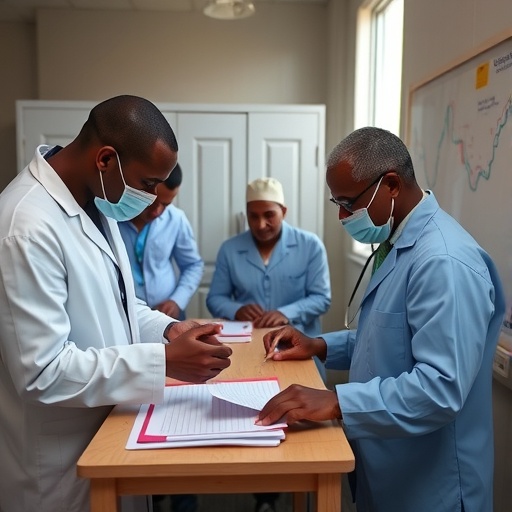Quality Concerns in Antibiotic Medications: A Study from Ethiopia
In a significant advancement for pharmaceutical quality assessment, researchers have unveiled critical insights into the efficacy of antibiotics commonly used in treating bacterial infections. A groundbreaking study conducted in Addis Ababa, Ethiopia, scrutinizes the quality of three widely available antibiotics: cephalexin, cefuroxime, and ceftriaxone. This comprehensive analysis employs a three-tier level approach paired with antimicrobial assays, delineating the alarming inconsistencies in drug potency that could have far-reaching consequences for public health.
Cephalexin is a first-generation cephalosporin, frequently prescribed for a multitude of infections due to its broad spectrum of activity. However, concerns have been raised regarding the authenticity and effectiveness of this antibiotic in some markets. By employing rigorous testing methodologies, researchers aimed to quantify the actual potency of cephalexin found in Addis Ababa, juxtaposing it against established pharmacopoeial standards. Findings from this investigation warrant serious consideration, especially in regions where bacterial resistance is an escalating threat.
Cefuroxime, a second-generation cephalosporin, serves as another focal point in the study. Often utilized to combat respiratory tract infections, this antibiotic’s market presence in developing nations has surged. However, the actual therapeutic benefits may be jeopardized if these medications fail to deliver their indicated dosages. Utilizing antimicrobial assays, researchers meticulously tested samples, revealing significant variances in cefuroxime’s concentration and purity, raising concerns about its role in effective patient recovery.
Ceftriaxone, a potent third-generation antibiotic, is pivotal in the treatment of serious infections like meningitis and sepsis. Despite its life-saving potential, there is growing unease regarding counterfeit and substandard medications infiltrating health care systems. The study’s findings underscore the critical need for enhanced regulatory oversight and improved supply chain transparency to ensure that patients receive medications that are both safe and effective.
In a bold bid to illuminate these discrepancies, the research team implemented a three-tier quality assessment framework. This methodology not only evaluates the chemical composition of the antibiotics but also assesses their microbiological efficacy. The authors advocate for applying such paradigms globally, as they could serve as a model for quality benchmarking in pharmaceutical production, especially within low-income countries where quality assurance is often neglected.
The impact of substandard antibiotics on public health cannot be overstated. When patients consume medications that do not meet quality standards, not only do they fail to combat the intended bacterial infections, but they may also contribute to the alarming rise in antibiotic resistance. This phenomenon endangers future therapeutic efficacy and poses severe risks to community health, as untreated infections can lead to hospitalizations and increased mortality rates.
Innovative solutions must be sought to mitigate the risks associated with low-quality medicine. Policy reforms and robust regulatory frameworks are imperative to ensure that all pharmaceutical products meet stringent quality standards. Collaboration between government agencies, health professionals, and pharmaceutical manufacturers will be vital in fostering an environment where quality can be reliably guaranteed.
Public awareness and education represent another crucial strategy in combating this issue. The general populace must be informed about the importance of obtaining medicines from reputable sources, as well as the potential dangers associated with counterfeit drugs. Empowering consumers with this knowledge can help them make more informed choices, ultimately leading to increased demand for quality-assured medications.
In parallel, the scientific community must prioritize ongoing research aimed at further understanding the implications of antibiotic quality on treatment outcomes. The findings from this Ethiopian study are merely a stepping stone towards a broader conversation centered around global health initiatives that prioritize the safety and efficacy of medications.
The implications of this study stretch beyond the borders of Ethiopia; they highlight a growing global challenge. Developing nations struggle against a backdrop of inadequate regulations and the proliferation of substandard medications. The urgent need for a coordinated response that encompasses improved quality control measures and international collaboration is evident.
The study’s outcomes also cast light on the necessity for continuous monitoring of the pharmaceutical market. Implementing routine inspections and rigorous testing of medications should become standard practice, ensuring that only safe and potent drugs are available to consumers. Such initiatives could act as a deterrent against the manufacture and sale of low-quality products.
The researchers hope that their work not only sheds light on the current state of antibiotic quality in Ethiopia but also inspires similar studies in other regions worldwide. Addressing these challenges can significantly improve health outcomes, particularly in vulnerable populations where access to quality medication is a pressing issue.
The need for sustained advocacy, education, and regulatory reforms becomes increasingly apparent. By forging tighter connections within the health ecosystem—between patients, providers, and policymakers—we can champion a future wherein access to effective antibiotics is a universal right rather than a privilege.
Ultimately, the findings of this study serve as a vital reminder of the responsibility held by all stakeholders in the healthcare system. Collaboratively striving for quality and transparency can produce significant improvements in antibiotic care and public health overall.
By leveraging the insights gained from this research, global health initiatives can better understand and address the pervasive issue of antibiotic quality. The interplay between effective treatment, patient safety, and public health equity hinges upon our collective action, guided by evidence and driven by compassion.
Innovative strategies and interdisciplinary collaborations promise a way forward, ensuring patients receive the high-quality medications they deserve. In doing so, we move closer to combating the tide of antibiotic resistance while safeguarding treatment efficacy for generations to come.
Subject of Research: Quality evaluation of antibiotics (cephalexin, cefuroxime, and ceftriaxone).
Article Title: Quality evaluation of cephalexin, cefuroxime, and ceftriaxone medicines marketed in Addis Ababa city, Ethiopia with three tier level approach and anti-microbial assays.
Article References:
Birhane, W., Getachew, T., Bitew, M. et al. Quality evaluation of cephalexin, cefuroxime, and ceftriaxone medicines marketed in Addis Ababa city, Ethiopia with three tier level approach and anti-microbial assays. BMC Pharmacol Toxicol 26, 169 (2025). https://doi.org/10.1186/s40360-025-01018-7
Image Credits: AI Generated
DOI:
Keywords: Antibiotic quality, cephalexin, cefuroxime, ceftriaxone, antimicrobial assays, healthcare quality, public health, antibiotic resistance, Ethiopia.




